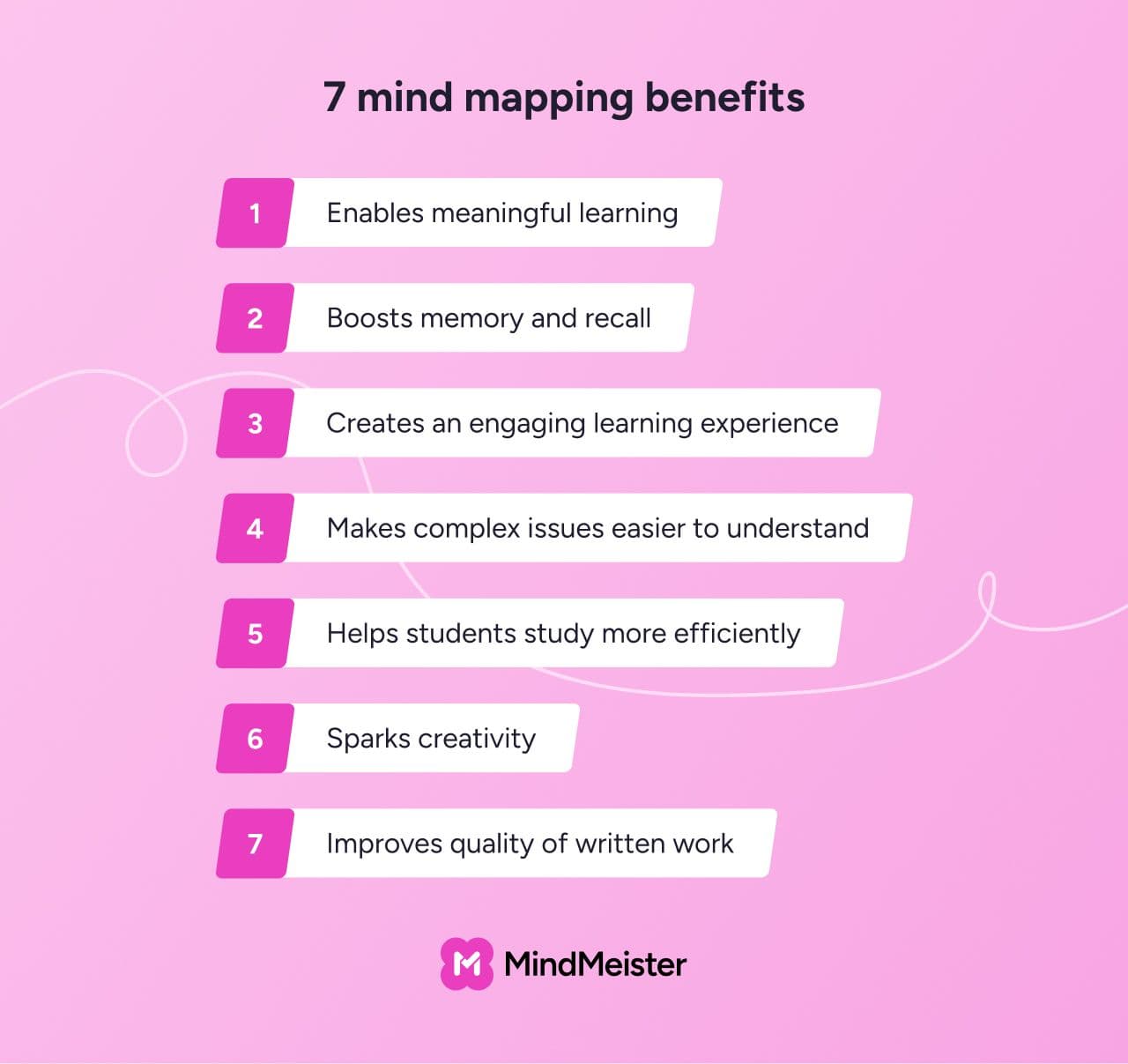7 mind mapping benefits for students

1. It enables meaningful learning
According to researchers, there are three levels of learning:
Non-learning is used to describe a state where there’s no measurable difference between a student’s knowledge before and after being taught new material.
Rote learning is used to describe when new knowledge is learned but not connected to any existing knowledge a student has on the subject.
Meaningful learning is used to describe when students have acquired new knowledge and have connected that new knowledge to knowledge they already had.
One big mind mapping benefit: it makes meaningful learning possible by visually linking new concepts to existing ideas. By mapping disparate pieces of knowledge around a central topic, students can form connections between what they already know and what they’ve just learned. It’s not just about memorizing facts. It’s about understanding the big picture and building long-term knowledge.
2. It boosts memory and recall
Back when writing things down was much more expensive and time-consuming, Greeks and Romans used a visualization technique called loci to memorize information. Essentially, they would develop mental visuals for the things they needed to remember, allowing them to recall large amounts of information — such as an entire speech — at will.
Mind mapping is a similar technique to loci and provides the same benefits for memorization and information retention. In one study, researchers found that studying with mind maps helped boost retention by 10-15%.
3. It creates a more engaging learning experience
Learning isn't just about absorbing information — it’s about staying interested. Mind mapping expert Martin Davies stresses that “meaningful engagement is a critical factor in promoting deeper learning.” Traditional methods like lectures and textbooks often don’t achieve this.
 Mind mapping does. One significant mind mapping benefit is that it’s active, not passive. Building a mind map involves brainstorming, structuring information and thinking critically about how concepts relate to one another. It turns learners into participants.
Mind mapping does. One significant mind mapping benefit is that it’s active, not passive. Building a mind map involves brainstorming, structuring information and thinking critically about how concepts relate to one another. It turns learners into participants.
Davies also suggests that having students create and compare their own maps can serve as a powerful learning and assessment tool. This peer-to-peer element not only builds understanding but boosts confidence in the material.
4. It makes complex issues easier to understand
In a 2017 survey from mind mapping expert Chuck Frey, most respondents said that the biggest benefit of mind mapping is that it helps them form an “improved understanding of complex issues.”
Whether it’s photosynthesis, trigonometry, or historical timelines, complex subjects can feel overwhelming for students. Mind mapping breaks that complexity into manageable, visual chunks.
By laying out information around a central idea, learners can clearly see how different concepts relate to one another. This method supports comprehension by helping students build connections between facts, ideas and themes. Instead of passively reading dense textbook paragraphs, they engage in active processing of information.
Another mind mapping benefit: Instructors can also use mind maps to introduce difficult material step-by-step, guiding students through visual summaries that simplify and clarify the most challenging concepts.
5. It helps students study more efficiently
Time is precious — especially during exam season. Mind mapping can help students spend it wisely. By summarizing large volumes of information in a single visual overview, it becomes easier to identify what’s important and remember it.
Chuck Frey's 2017 study shows that mind mapping can dramatically improve time management in a business setting. In a classroom context, this means students can cut down on repetitive note reviews and instead focus on understanding the core ideas. Teachers can also use mind maps to present overviews of entire units, making it easier for students to revisit key points quickly.
Whether it's preparing for a test or writing a paper, mind maps help students stay focused, save time, and feel more confident in their knowledge.
6. It sparks creativity
The final takeaway we’ll share from Frey’s survey on the benefits of mind mapping is that respondents said it helps them increase their creativity. In fact, beginner and expert users alike said that mind mapping provides them with a 50% increase in creativity.
 In school, creativity isn't limited to art class. It plays a vital role in how students explore, understand, and express ideas across all subjects. Mind mapping gives learners the freedom to think creatively by allowing them to visually brainstorm, connect ideas, and structure their thoughts in a non-linear way.
In school, creativity isn't limited to art class. It plays a vital role in how students explore, understand, and express ideas across all subjects. Mind mapping gives learners the freedom to think creatively by allowing them to visually brainstorm, connect ideas, and structure their thoughts in a non-linear way.
This open format helps students move beyond memorization to idea generation. Whether they’re writing a story, preparing a science project, or analyzing a piece of literature, mind maps encourage original thinking and deeper engagement.
7. It makes writing easier — and improves quality
Organizing your thoughts before writing leads to better results. In a 2009 study comparing two groups of students, only one used mind mapping software in addition to traditional writing instruction.
The difference was clear: Students who used mind maps wrote more detailed, better structured, and more connected paragraphs than those in the control group. Although both groups started at the same skill level, the mind mapping group achieved higher gains in writing performance.
In short: mapping before you write makes writing easier — and your final work stronger. Yet another mind mapping benefit that can improve students' experience in the classroom.
Getting started with mind mapping
MindMeister makes it easy to get started with mind mapping. Sign up for our free plan to create your first mind map, or if you need help learning how to create and use mind maps, check out our free Mind Mapping 101 course.
